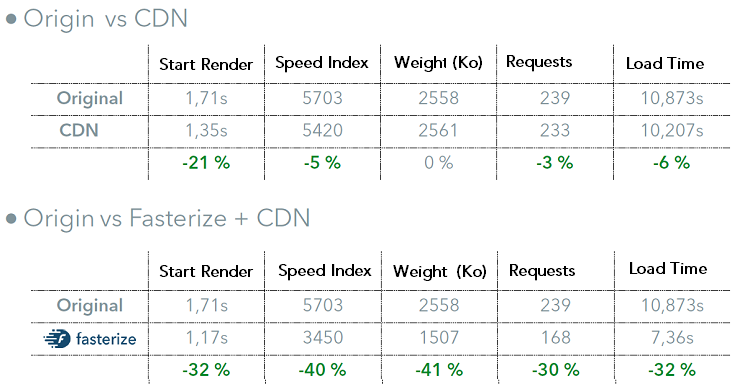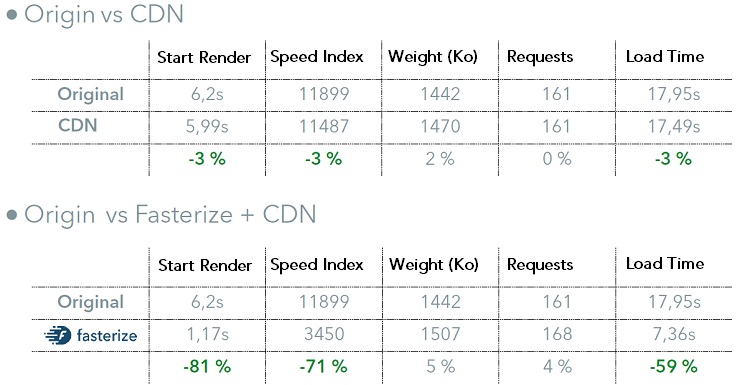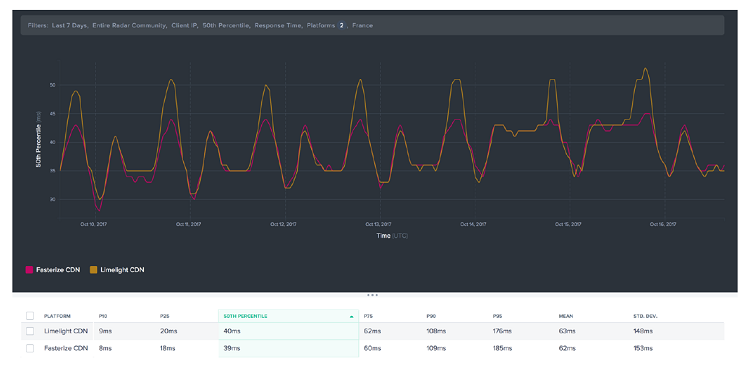
The Content Delivery Network (or CDN) is one of the basics of web performance. By acting as an online ‘relay’, it allows you to create a bridge between content and users. This ensures that the distance information must travel from server to user is as short as possible – and the shorter the distance, the faster the response.
For those who wish to optimise loading times, this technique is often the first port of call. Yet how do you measure its impact? Should you use one CDN or several? And how do you choose between them? Let’s cast the spotlight on this invaluable solution.
The ROI of CDN
The most common scenario that incites developers to acquire a CDN is this: content is served from one geographical region, whereas traffic originates elsewhere. As a result, content is cached and relayed by a CDN or by a cache server to improve the speed of the website.
The results are more or less the same with both options. More precisely, given that CDNs exist to optimise content delivery, these companies will often have agreements in place with ISPs that situate them closer (in network terms) than the cache servers of hosting companies, thus offering slightly better performance.
That said, let’s address the elephant in the room: when used over a short distance (e.g. for a French website with users in France), a CDN will only boost web performance by a few percent – which is rather low in relation to its cost.
Monthly expenditure can reach well upwards of 2,500 euros for websites with high traffic volume, resulting in a waterfall that remains fundamentally unchanged. At best, you can hope to save 3 to 5 ms for content that a cache server would take 40 ms to deliver, which hardly makes an overwhelming case. In reality, using a CDN alone generates a negligible ROI. So, why use one at all?
To really understand the advantages of a CDN and how to choose from the CDNs on the market, we’ve compared a selection of indicators for pages:
- without a CDN and without frontend optimizations
- with a CDN and without frontend optimizations
- with a CDN and with frontend optimization via our Fasterize engine

Desktop comparison

Mobile comparison
One of (so) many web performance optimisations
In the case of loading times affected by long distances that content has to travel between server and user, the benefits of using a CDN are plain to see. In general, there is not much difference in performance from one CDN to another, and the differences in gains and investment can be difficult to justify.

Note that these differences can be extremely significant in certain geographical regions considered “complex” by virtue of their size or limited infrastructure (Brazil, Russia, China, India and Africa).
In other words, bridging the distance between content and users is a good thing, but a heavy webpage is still going to be heavy. And if you have a large number of requests to load that page, the CDN will not make them magically disappear. Yes, it serves a necessary and specific purpose, however, it’s not a catch-all solution to every issue behind a sluggish website. One thing it certainly does not deliver is frontend optimization.
Compared with using a CDN by itself, it goes without saying that web performance optimisation requires additional investment in terms of both time and resources, yet these optimisations are what enable you to achieve better performance and get a return on your investment.
As for those CDNs that do more than bring content closer to users as a mere convenience, they can offer a range of different functionality: content optimisation, security, application software, etc. To find out which is the best to use, let’s place the latest technology under the microscope.
How do you choose the right CDN? And is one enough?
Frontend and security
CDNs are evolving to become increasingly intelligent! Some are capable of unitary content transformation, for example, of minifying JavaScript or CSS files, of compressing and resizing images, and much more besides. Without going so far as to rewrite code, they offer similar features to frontend optimization tools.
Others boast security features: anti-DDoS, WAF or anti-bot.
Technology stack
In addition, some CDNs provide functionality that allows you to benefit from the latest web performance technology. Examples include HTTP/2 and TLS1.3 support – features that tend to operate on the tech stack side and are less visible to end users.
Notably, most requests on the web are made with HTTPS (around 87%) and Fasterize helps you significantly speed up your HTTPS website by optimising the TLS layer with different techniques that we detail here:
- a suite of ciphers controlling forward secrecy,
- OCSP stapling,
- support for TLS session IDs and tickets,
- TLS false start.
You should also be aware that certain stakeholders still charge a considerable amount for TLS certificates. Why the charge? It’s a hangover from the days when powerful CPUs were needed to decrypt every exchange. Seeing as this is no longer the case, it would be a shame to keep paying for SSL (or these days TLS). The good news is that many companies – including Fasterize – now offer this for free.
What about a multi-CDN?
The question of whether to use multi-CDN is largely applicable to sites of international scale, for instance, in the luxury market or car manufacturing sector.
Previously, a website might have employed several CDNs according to the required functionality and geographical coverage, thus adding a layer of complexity to the configuration of each one.
Today, you’re better off using multi-CDNs for what they do best – delivering content – and leaving the advanced functionality and cache configurations to specialised companies such as Fasterize, or else managing these in house.
In summary, CDNs have already evolved to provide far more functionality than reducing distances between content and web surfers. But what does the future hold?
The future of CDNs: ever-growing functionality
As they are fast becoming smarter, we are seeing the emergence of CDNs “at the edge”: equipped with Service Workers that enable light application software on CDN servers. By way of example, cookie-based redirection is coded within the CDN instead of going back to the origin server.
Other CDNs are also starting to perform Machine Learning based on the data they transit, thus learning from the traffic that passes through them. For instance, recurring traffic can be cached automatically, even when it is not flagged as being cacheable.
Great strides are being made with this technology and, naturally, we are eager to see what comes next on the horizon.
From simply moving content closer to users, to content optimisation and security, the market has an abundance of stakeholders. All that remains is to identify the functionality that suits your needs!
Find out more about the Fasterize CDN offering
and learn how our automated web performance optimizations
can make your website faster and your conversion rate grow:
